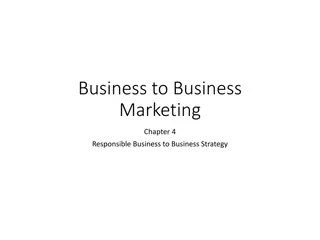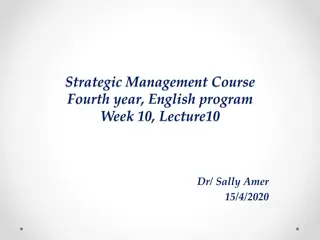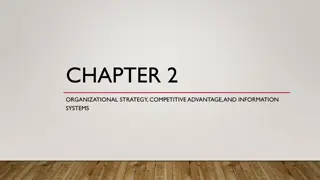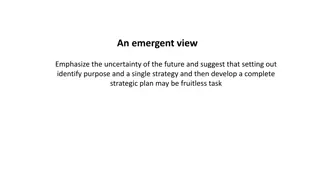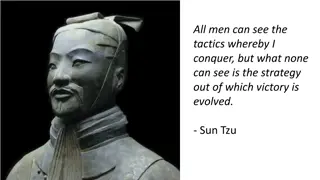Understanding the Concept of Strategy in Business Policy and Strategic Management
The concept of strategy, derived from military principles, plays a crucial role in business policy and strategic management. It involves mobilizing resources to achieve organizational goals and move towards a desired future state. Strategic management features objectives, future orientation, resource allocation, environmental influences, and more.
Download Presentation

Please find below an Image/Link to download the presentation.
The content on the website is provided AS IS for your information and personal use only. It may not be sold, licensed, or shared on other websites without obtaining consent from the author. Download presentation by click this link. If you encounter any issues during the download, it is possible that the publisher has removed the file from their server.
E N D
Presentation Transcript
concept The concept of strategy is undoubtedly the most significant concept in business policy and strategic management. The concept of strategy is derived from military principles. In military context, the strategy is a plan of action to win a war. Here military identify the quality and quantity of resources to be mobilized and used at the most appropriate time in suitable and convenient manner to win a war.
In business parlance, there is no definite meaning of strategy and used for number of things like mobilizing and deploying resources systematically and attain organizational goal or the pattern of common thread related to the organization s activities which are derived from the policies and objectives and goals. It is related to pursuing those activities which move an organization from its current position to desired future state. It also relates to resources necessary for implementing a plan or following a course of action.
features Following are the features of strategic management. 1. Objective. 2. Future oriented. 3. Availability and allocation of resources. 4. Influences of Environment. 5. Universal applicability. 6. Levels of strategy. 7. Review.
1. Objective Oriented: The business strategies are objectives oriented and are directed towards organizational goal. To formulate strategies the business should know the objectives that are to be pursued. For example if any business want to achieve growth then it has to set following objectives. a) To increase market share. b) To increase customers satisfaction. c) To enhance the goodwill of the firm.
2. Future Oriented: Strategy is future oriented plan and formulated to attain future position of the organization. Therefore strategy enables management to study the present position of organization and decides to attain the future position of the organization. This is possible because strategy answer question relating to the following aspects. a) Prosperity of the business in future. b) The profitability of the business in future. c) The scope to develop and grow in future in different business.
3.Availability andAllocation of Resources: To implement strategy properly there is need of adequate resources and proper allocation of resources. If it is done then business can attain its objectives. There are three types of resources required by business namely physical resources, i.e plant and machinery, financial resources i.e capital, and human resources i.e manpower. If these resources are properly audited/evaluated and find out its strength and weaknesses and co-ordinate well then management implementation. can do better strategy
4. Influence of Environment: The environmental factors affect the formulation and implementation of strategy. The business unit by analyzing internal and external environment can find out its strength and weaknesses as well as opportunities and threats and can formulate its strategy properly. 5. UniversallyApplicable: Strategies are universally applicable and accepted irrespective of business nature and size. Every business unit designs strategy for its survival and growth. The presence of strategy keeps business moving in right direction.
6. Levels of strategy: There are companies that are working in different business lines with regards to products /services, markets or technologies and are managed by same top management. In this case such companies need to frame different strategies. The strategies are executed at three different levels such as a) Corporate level b) Business level c) Functional/operational level





